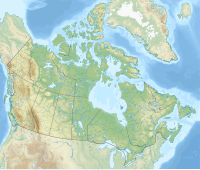Mount Fifi
Appearance
| Mount Fifi | |
|---|---|
 Mount Fifi seen from Johnson Lake | |
| Highest point | |
| Elevation | 2,621 m (8,599 ft)[1] |
| Prominence | 106 m (348 ft)[note 1] |
| Listing | Mountains of Alberta |
| Coordinates | 51°13′23″N 115°41′35″W / 51.22306°N 115.69306°W |
| Geography | |
| Location | Alberta, Canada |
| Parent range | Sawback Range Canadian Rockies |
| Topo map | NTS 82O/04 |
| Climbing | |
| First ascent | 1921 L.S. Crosby, J.W.A. Hickson, Edward Feuz Jr. |

Mount Fifi was named in 1886 after Edith Orde's dog Fifi. Mount Louis, Mount Edith, and Mount Fifi were named on the trip. It is located in the Sawback range of Banff National Park, Alberta.[1][2]
Geology
Mount Fifi is composed of limestone, a sedimentary rock laid down from the Precambrian to Jurassic periods.[3] Formed in shallow seas, this sedimentary rock was pushed east and over the top of younger rock during the Laramide orogeny.[4]
Climate
Based on the Köppen climate classification, Mount Fifi is located in a subarctic climate with cold, snowy winters, and mild summers.[5] Temperatures can drop below -20 C with wind chill factors below -30 C. Weather conditions during summer months are optimum for climbing.
See also
References
- ^ a b "Mount Fifi". cdnrockiesdatabases.ca. Retrieved 2019-08-28.
- ^ "Mount Fifi". Bivouac.com. Retrieved 2019-08-28.
- ^ Belyea, Helen (1960). The Story of the Mountains in Banff National Park (PDF) (Report). Geological Survey of Canada. Archived (PDF) from the original on 2 October 2015. Retrieved 2019-06-23.
- ^ Gadd, Ben (2008). "Geology of the Rocky Mountains and Columbias".
{{cite web}}: Missing or empty|url=(help) - ^ Peel, M. C.; Finlayson, B. L.; McMahon, T. A. (2007). "Updated world map of the Köppen−Geiger climate classification". Hydrol. Earth Syst. Sci. 11: 1633–1644. ISSN 1027-5606.
{{cite journal}}: Unknown parameter|last-author-amp=ignored (|name-list-style=suggested) (help)
- Footnotes
- ^ Bivouac and Peakfinder differ as to summit elevation by 16 m. Thus, 16 was subtracted from the prominence of 122 given by Bivouac.
External links
 Media related to Mount Fifi at Wikimedia Commons
Media related to Mount Fifi at Wikimedia Commons- National Park Service web site: Banff National Park


